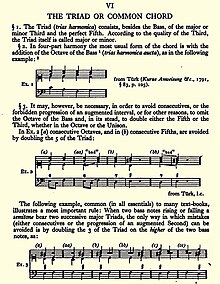|
F. T. Arnold Franck Thomas Arnold (1861-1940) was an Anglo-German musicologist and bibliophile. A self-taught scholar with a day job, he is best known for his The Art of Accompaniment from a Thorough-Bass (1931), described as the finest piece of musicography ever produced in England. LifeArnold was born in Rugby, Warwickshire, on 6 September 1861, third son of the Rev. Charles Arnold, an assistant master at Rugby School, and Susanna Magdalena née Mays. The family was probably bilingual. His mother had been born in Heidelberg, where his father married her in separate Lutheran and Anglican ceremonies. Arnold seems to have been proud of his German roots.[1] The Arnolds were a well-established family in Lowestoft with distinguished naval forebears; they were related to Dr Arnold of Rugby the famous headmaster.[2] After attending Rugby and Trinity College, Cambridge, in 1886 Arnold was appointed lecturer in German Language and Literature at the University College of South Wales and Monmouth – afterwards Cardiff University – a post he held for forty years. It allowed him enough spare time to devote to his musicological pursuits. He was a keen amateur cellist.[3] In 1887 he married Edith Maud Kelly. Their first son was given the somewhat Germanic names Karl Ferdinand Franck William.[4] He became a captain in the British army and was killed at Zonnebeke near Ypres in 1915 after German forces enfiladed his trench.[5] Franck Arnold died in Bath on 24 September 1940.[6] WorkThe lost art of playing from figured bassComposers of the Baroque era seldom wrote out musical accompaniments. Performers were expected to improvise (realize) these to suit the occasion, guided by no more than a bare sketch called a figured bass (or thorough-bass). A figured bass was analogous to the lead sheets used by the rhythm sections in present-day bands, but realizing a figured bass was more demanding, because tight voice leading rules constrained what realizations were acceptable. Not only did the correct chords have to be played: the middle voices of those chords had to succeed each other faultlessly according to certain rules.[7][8] Despite those difficulties, competent musicians acquired the art of improvising an acceptable accompaniment from a figured bass, and doing so at sight.[9] However, after the Baroque era the art was gradually forgotten. Arnold's aim was to recover it. By teaching oneself this lost art, wrote Arnold, "an immense storehouse of music is opened which can be enjoyed in no other way". Further,
Arnold had only wanted to teach himself how to accompany from old figured basses; he had no thought of writing a book. But the rules of Baroque harmony were quite strict, and when he tried to play he found he was running into many problems, technical and artistic, to which modern textbooks seemed to supply no answers.[11] Arnold's approachThere were thorough modern works by German authors, but these writers were scholarly historians with no particular interest in teaching modern performers how to play from a figured bass. In contrast, Arnold was a performer – talented perhaps, but amateur – who had the zeal to teach himself to be a scholar.[12] Arnold's approach was to recover the old learning, insofar as it was in writing and had survived, and to compile a synthesis of this knowledge illustrated by many practical examples. The task took him over 40 years. Old treatises on figured bass realization existed, but they were exceedingly rare, and scattered about Europe. Arnold made it his purpose to hunt them down and acquire them. He also sought old musical scores if they threw some light om practical problems and performing practices of the era.[3] The Arnold Thorough-bass CollectionOver many years he amassed an important collection, which he afterward bequeathed to Cambridge University. Wrote Cambridge University music librarian Donald R. Wakeling, "Arnold in his search for a full knowledge of his subject was not content with drawing upon the resources of the libraries of Europe, but he also bought for himself all available literature and music from which he could absorb and note at leisure anything relating to thorough-bass".[3] Describing his collection in his book (1931) Arnold himself said:
Like a true bibliophile,
The bookIn 1931, despite the Depression and a thin subscription list, the Oxford University Press published his The Art of Accompaniment from a Thorough-Bass as Practised in the XVIIth and XVIIIth Centuries.[15] Its first sentence reads:
His 'adequate' information was exhaustive: the book's 918 pages cited the works of 110 Baroque practitioners, well known and obscure, with a wealth of practical examples.[16] AcclaimWilliam Gillies Whittaker the book's first reviewer described it as "an amazing product of prolonged investigation and accurate scholarship".[17] To R.O. Morris (then professor of counterpoint at the Royal College of Music) it seemed "certain to stand for all human time as the standard work of reference".[18] Sunday Times critic Ernest Newman said it was "the finest piece of musicography ever produced" in England.[19] Other reviewers have described it as a "classic";[20] "this great work;[21] the standard authority;[3][22] "likely to remain the starting point for any serious study".[23] Stanley Sadie said it was a "must have".[24] One reviewer wrote: "This famous book does not need a review".[25] Although Arnold published other works – he wrote the article on Thorough-bass for Grove's Dictionary of Music and Musicians – his masterpiece was his book.[3] Further editionsA two-volume paperback edition was published by Dover Books (1965).[26] A Kindle version is available.[27] References and notes
Sources
|